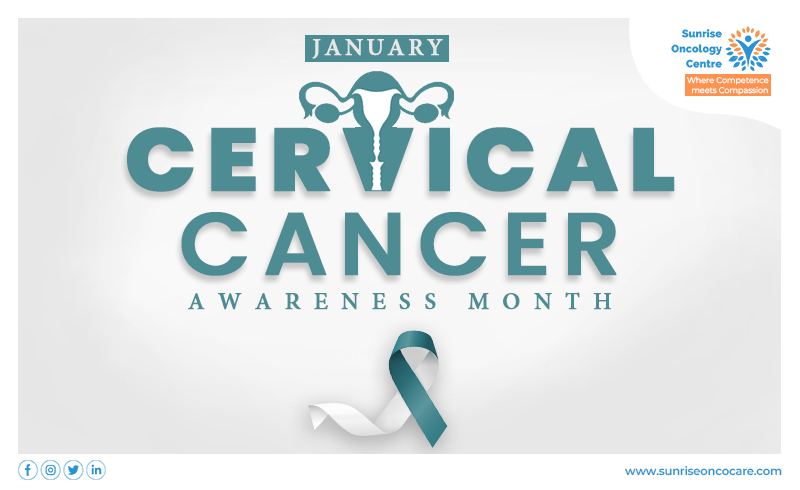Cervical cancer develops in a woman’s cervix. The cervix connects the upper part of the uterus (womb) to the vagina, and it is one of the slow-developing cancers. A sexually transmitted infection called high-risk human papillomavirus (HPV) is responsible for 99% of instances of cervical cancer.1,2
However, cervical cancer is extremely curable and has a good survival rate if it is detected early.1
Cervical cancer is the 4th most common type of cancer found in women.2
The cervix has 2 main parts:1
The ectocervix: it is the outer part of the cervix covered with thin, flat cells called squamous cells.
The endocervix: It is the inner part of the cervix and is covered with glandular cells that make mucus.
Most cervical cancers begin in the border where the endocervix and ectocervix meet.
The ectocervix: (also called exocervix) is the outer part of the cervix covered with thin, flat cells called squamous cells.
Types of cervical cancers:1
The type of cervical cancer develops from the cells that are present in the cervix.
Squamous cell carcinoma: 90% of cervical cancers are squamous cell carcinomas.
Adenocarcinoma: This type develops in the glandular cells.
Sometimes cancer develops in both glandular and squamous cells and this is called mixed carcinoma.
Signs and Symptoms:3,4
It is typically difficult to identify cervical cancer in its early stages since it has no symptoms. The following are the early signs of cervical cancer:
- Watery vaginal discharge or odour
- Pelvic pain or pain during sex
- Vaginal bleeding after sexual intercourse, after menopause, or between periods.
- Swelling in the legs
- Painful urination or difficulty in urination
- Blood in the urine
- Dull backache and neck pain
- Fatigue, loss of weight, and appetite
Risk factors for cervical cancer:5
Some risk factors increase a person’s likelihood of developing a persistent infection that results in serious cervical cell alterations that can turn into cervical cancer after contracting a high-risk HPV infection of the cervix.
- Weak immune system: The presence of HPV and other health conditions has an effect on one’s immune system and this increases the likeliness of the development of cervical cancer. HPV infections are more likely to be persistent and progress to cancer in immunocompromised individuals.
- Smoking/ Passive smoking: People who smoke or breathe second-hand smoke have an increased risk of developing cervical cancer.
- Multiple sexual partners: The chance of acquiring HPV increases if the number of sexual partners is greater.
- Sexually active at an early age: The risk of HPV infection is high in people who become sexually active before the age of 18. The sexual history increases the chances of exposure.
- Other sexually transmitted infections (STIs): Having other STIs (chlamydia, gonorrhea, syphilis, and HIV/AIDS) increases the risk of HPV.
Complications:6
- Like other cancers, cervical cancer can spread to other parts of the body and cause serious complications.
- The likelihood of miscarriage increases following cervical cancer treatments and might damage your ability to become pregnant or carry a pregnancy to term.
- Cancer treatments including surgery, chemotherapy, and radiotherapy can cause many side effects.
- Loss of fertility: Some women will need to have parts of their reproductive system removed to treat cancer.
- Kidney Damage: Chemotherapy might cause permanent kidney damage.
- Leukemia: Chemotherapy may damage the bone marrow which could lead to myeloid leukemia.
Prevention:5,7
Nearly all cervical cancers can be prevented if caught early. Some things can be done to prevent pre-cancers and conditions that lead to pre-cancers.
- HPV vaccination: The HPV vaccination is a safe and effective strategy to help prevent cervical cancer since it protects against infection with the HPV strains that are most often connected to cancer. Before being exposed to HPV, a person should take the HPV vaccine
- Limit exposure to HPV: HPV may spread without sex because it is passed from one person to another by skin-to-skin contact with an infected part of the body. Your chance of being exposed to HPV may be reduced by limiting the number of sexual partners you have and avoiding those who have had numerous sex partners.
- Use a condom: Although they can guard against HPV, condoms cannot entirely prevent infection. Areas, where the condom is not present, are nevertheless susceptible to HPV exposure. However, it offers some HPV protection as well as protection from other STDs.
- Quit smoking: Not smoking is an important way to reduce the risk of cervical cancer.
- Cervical cancer screening: Routine cervical cancer screening with the HPV test and Pap test can find abnormal cell changes and precancers that can be treated before they turn into cancer. Women need to have regular screening tests from their early 20s.
Cervical Cancer Awareness Month is observed every year in January. It might be challenging to diagnose cervical cancer since it frequently goes unnoticed at an early stage. Understanding the early warning signs and symptoms of cervical cancer can reduce deaths and save many lives. Therefore, increasing people’s awareness of early symptoms and indicators and educating them is essential.8
References:
- What is cervical cancer, available at: https://www.cancer.gov/types/cervical, Last accessed on 9th January 2023.
- Cervical cancer, available at: https://www.who.int/health-topics/cervical-cancer#tab=tab_1Last accessed on 9th January 2023.
- Cervical cancer symptoms, available at: https://www.cancer.gov/types/cervical/symptoms, last accessed on 9th January 2023.
- Understanding cervical cancer, available at: https://www.webmd.com/cancer/cervical-cancer/understanding-cervical-cancer-symptoms last accessed on 9th January 2023.
- Cervical Cancer Causes, Risk factors, and Prevention, available at: https://www.cancer.gov/types/cervical/causes-risk-prevention last accessed on 9thJanuary 2023.
- Cervical Cancer, available at: https://www.healthdirect.gov.au/cervical-cancer last accessed on 9th January 2023.
- Can cervical cancer be prevented, available at: https://www.cancer.org/cancer/cervical-cancer/causes-risks-prevention/prevention.html last accessed on 9th January 2023.
- Cervical cancer awareness month, available at:https://www.emro.who.int/noncommunicable-diseases/campaigns/cervical-cancer-awareness-month-2023.html, last accessed on 9th January 2023.

